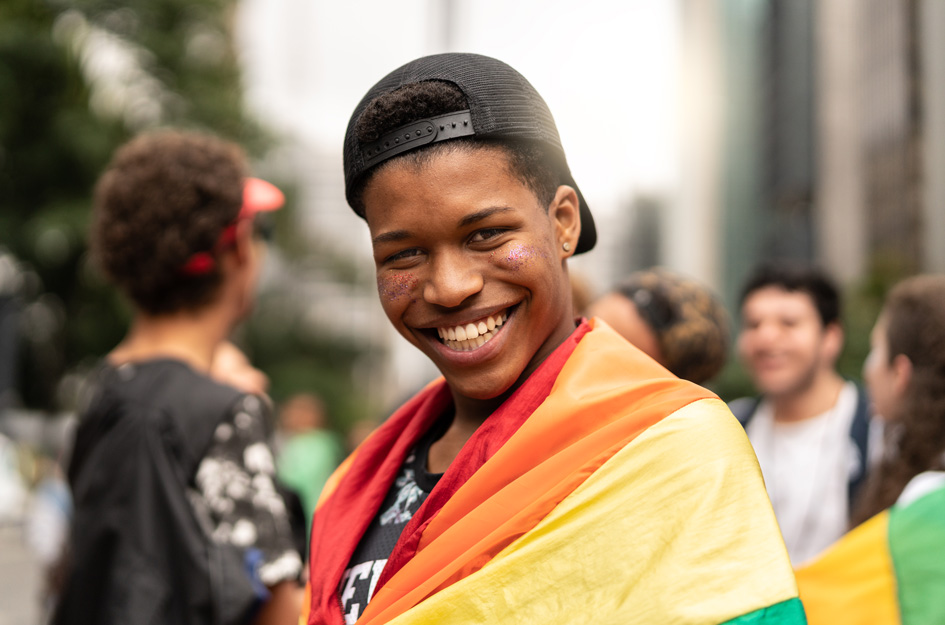

By creating safe, welcoming places for all, we can support LGBTQ young people – who face unique challenges to their mental health, academic success and wellbeing – in knowing they are accepted as they are.
I grew up in a rural town. My parents were super strict and held many traditionally conservative values. From an early age, I remember feeling different from family and friends in a way that I couldn’t quite articulate, but I sensed that it wasn’t safe to explore or examine my identity.
In high school, an English teacher introduced me to early feminist texts and other women’s literature that opened up my world. I credit her with helping me take the first step on my journey to coming out. Those books showed me that life wasn’t binary and there were all these different ways of being – and that they were all valid.
Being inclusive means that we are actively working to create safe, welcoming spaces for all people through our words and actions.
Sometimes what an LGBTQ youth needs is for one adult to step up and demonstrate that every person matters in that space, exactly as they are.
It’s not about telling a young person they’re gay or defining their identity for them. It’s about letting kids know that we see them, and we accept them for whoever they are or may turn out to be, as they continue to explore.
A universal truth of human development is that we all need to be seen, heard and valued. For LGBTQ youth, finding that acceptance at school and home can feel like an impossible hill to climb.
According to GLSEN’s 2019 National School Climate Survey, 59.1% of LGBTQ students felt unsafe at school because of their sexual orientation, 42.5% because of their gender expression and 37.4% because of their gender. And nearly a fifth of all LGBTQ students (17.1%) reported having ever changed schools due to feeling unsafe or uncomfortable. LGBTQ youth are also more likely than their peers to be forced to leave their homes, accounting for a disproportionate 40% of the youth homeless population.
These negative outcomes are solvable when we choose to be inclusive as friends, family members, educators and youth development professionals, and in any other role that brings us into the lives of young people. According to the Trevor Project, just one accepting adult can reduce the risk of a suicide attempt by 40% in LGBTQ youth.
Boys & Girls Clubs of America’s commitment to inclusion underscores our continued dedication to doing whatever it takes to position our youth for great futures, including young people of every gender, gender expression and sexual orientation.
We continue to make programming and trainings available to help Club staff learn how to best support LGBTQ youth. Some Club members have even taken the lead themselves by starting GSAs (Gender & Sexuality Alliances), which unite LGBTQ and allied youth to act as advocates for trans and queer young people in their Clubs and larger communities. And we’re proud when kids at Clubs know that they belong, just as they are.
There is much work still left to do to support equity for all, and Boys & Girls Clubs of America is committed to being part of the solution by providing emotionally and physically safe spaces for the 460,000 kids who enter Club doors daily during a typical year.
It will take all of us, actively promoting inclusive, affirming spaces in our personal and professional lives, to ensure that all members of the LGBTQ community, especially our youth, feel welcome and supported. Here are a few recommendations for how to become part of the solution with a young person in your life.
Learn more about Boys & Girls Clubs of America’s resources for LGBTQ youth, families and allies.
We are working to ensure that who you are, where you're from or the circumstances that surround you don’t determine your access to experiences or opportunities. With your support, Boys & Girls Clubs are making that vision a reality — in your community and communities around the world.
This updated story was originally posted on June 17, 2019.
We use cookies to enhance your experience. Learn More.
Boys & Girls Clubs of America uses cookies to give you the best experience on our website. Read about cookies in our privacy policy. By closing this message, you consent to our use of cookies on this device in accordance with our policy unless you have disabled them.